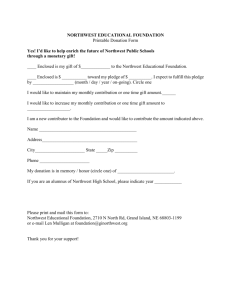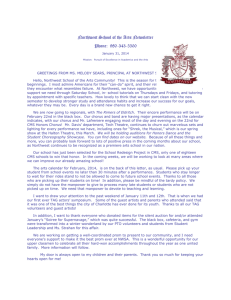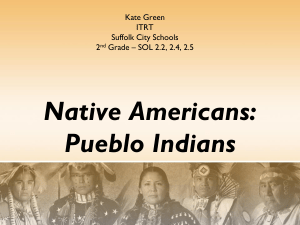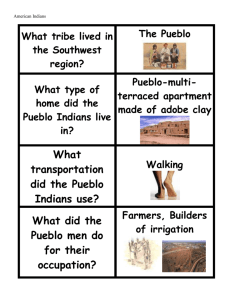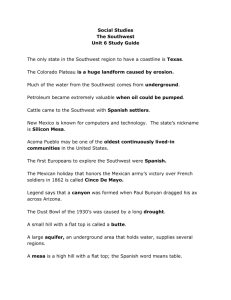Native Americans
advertisement
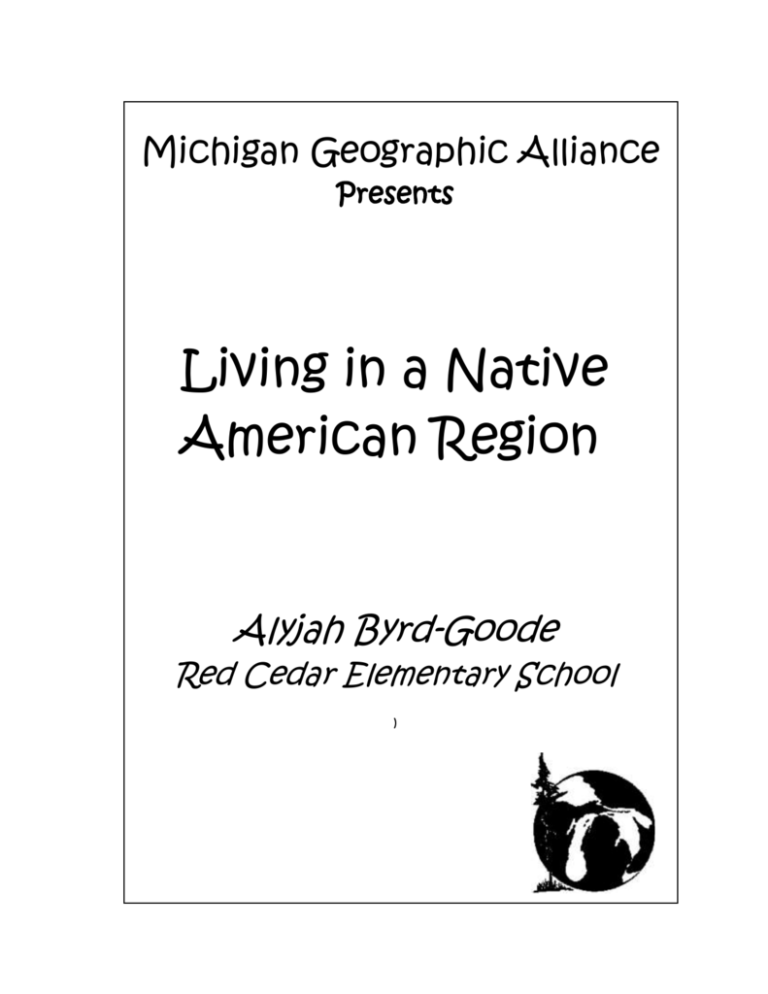
Michigan Geographic Alliance Presents Living in a Native American Region Alyjah Byrd-Goode Red Cedar Elementary School ) Living in a Native American Region Alyjah Byrd-Goode, Red Cedar Elementary School, E. Lansing, MI 48823 Grade Level: 5th Grade Grade Level Content Expectation(s) Locate and describe major places, cultures, and communities in Native American life. II.1.LE.3 Interpret and analyze social science information about the United States from maps, graphs, charts, tables, and pictographs. V.1.LE.3 Lesson Overview This lesson focuses on one of the five themes: region. The activity will have students compare and contrast at least two different Native American regions. As students work through the lesson reading skills will also be enhanced. Objectives Students will be able to: Locate the major Native American regions of the United States on a map. Describe the physical and human characteristics of Native American regions. Identify and organize data about Native American regions from selected reading. Identify and explain preferences that Native American used for choosing a place to live and why. Materials Needed Outline map of Native American regions - one per student Reading selection pull cards (Native American Region cards - copy and cut apart one set) Five themes poster one per group of 3-5 Five themes review cards - cut into apart one set. Transparencies: environmental conditions map, outline map of Native American regions, compare/contrast, graphic organizer Student reading selections - Native Americans of the Southwest and Pacific Northwest-one per student Watercolor markers or colored pencils - (students need) Venn diagram-Compare/contrast Native American Regions-one per student Graphic organizer-Native Americans of the _____Region - one per student Teacher background Notes See student readings. Also, if students have not had prior experience highlighting information from a reading selection, you might want to model how this technique is done prior to this lesson. Procedure for Activity 1. Review of all 5 Themes of Geography (short activity) a. Pass out five themes poster for each group of 3-5 students. b. Teacher pulls one of the themes from a container and reads the statement of question. Example, PLACE: Describe the place. ASK: Who can think of something in the school environment that is an example of place? c. Once answered correctly then that student can pull another review card from the container. Continue until all cards have been pulled and answered. 2. Lesson Focus-Region a. Show the region card again. Ask the class if they can think of something in Michigan that is an example of region? (Michigan is part of the Great Lakes region, forests, upper-mountains, tall trees, waterfalls, small towns, open spaces, quiet roads, and lower peninsula-rolling hills, farmland, big cities, busy highways.) b. Next, have students name a region of the U.S. Choose one of the regions named by a student because they are going to visualize using it. Tell them we are all going there in our minds. Close your eyes and ask: What do you see in front of you? In back of you? Describe it in your mind. What can you feel with your hands, feet, on your skin? Describe it. Look all around you, what is happening? What can you hear? After a while have students mentally come back to the classroom. Share what they discovered; record on the overhead or chart paper. c. Ask the class: What is a region? Turn to a buddy and discuss. Write down ideas on chart/overhead. d. On the overhead show the map of lightning hazards and ask students to explain or tell about this map. Share ideas about how the lightning information forms a region. e. Conclude with, and tease out of the student suggestions that: a region is an area on Earth with one or more common characteristics (use the example of lightning hazards to encourage them to reach a definition of region; the students may suggest forest region, beach region, urban region. 3. Native American Regions a. Pass out a copy of the U.S. map to each student. One child from each group will pull a card from a container, which will tell them the Native American region they will research and the data they will collect. Locate the region on the map of the U.S. Using a colored pencil or other color utensil students will locate, color, and label the region that was selected. b. Each student receives the Native Americans of ____ Region organizer. Using the 5 themes poster students make predictions about the region they will learn about. Before students start the activity, ask for ideas about their region and model how to record information on the organizer using the overhead. c. Each student will then receive an article to read about his or her region. Students can work together in their group or independently to read the selection. They will highlight using a colored utensil, the information in the article pertaining to their Native American region. d. After reading, instruct the students to use color pencils and add any new information from the article to the organizer. They can also circle information listed on the organizer from the predictions they made earlier to indicate whether or not prior knowledge was verified by the article. e. Students next compare/contrast the information about their region with a classmate who researched another region. f. Review the information that students have organized and discuss how the information may be used to write a short essay. Review the way that information in notes, such as the Venn Diagram, may be used to write a short essay. Next, ask students to complete the following story A Place to Live It is 1650 and I am moving from England to the New World. I want to move to the (insert your choice of a region here). I want to have a good life. I have selected this region because: Assessment Have students explore another Native American region. Direct the students to prepare a Venn diagram that compares and contrasts the region they researched with the new region. References Hakim, Joy, The First Americans www.u-s-history.com/ www.edhelper.com/ReadingComprehension_31_38.html Materials and student sheets (blackline masters) Five Themes Review Cards PLACE Describe what the place is like. HUMAN ENVIRONMENT INTERACTION Describe how people have changed their environment. LOCATION Describe where it is. Why is it located there? MOVEMENT Describe how people are linked or connected. REGION Describe the common characteristics of an area. Name________________________________ Date_______________________ Native American of the ____________________________ Region Physical Characteristics Human Characteristics Native American Region Cards PLAINS EASTERN WOODLANDS PACIFIC NORTHWEST COAST CALIFORNIA INTERMOUNTAIN SOUTHWEST Native Americans of the Southwest Region The Southwest region of Native Americans is what are now considered Arizona, New Mexico, and parts of Colorado and Utah. This is a land of majesty and contrast with both mountains and deserts. There is scorching heat in the summer and cold in the winter. Around 10,000 years ago, prehistoric people lived in this area. There was enough rain at the time for mammoths and bison so the people hunted them. 2,100 years ago the Anazazi, or ancestral Pueblo people, were also here. They were referred to as Basket Makers. Thy hunted with a spear thrower and gathered wild foods but they were known for their fine baskets made from rushes, straw, and other materials. They lived in large pit houses, dwellings with sunken floors topped by timber frameworks covered with mud. By about A.D. 700, the Basket Makers had evolved into the early Pueblo culture. They started to build their famous pueblo dwellings during the next 200 years. Sometimes they wee built on cliffs, hence the term Cliff Dwellers. “Imagine that you are an Indian boy, not quite a year old. Your mother is carrying you to the fields. You are strapped to a board on her back.” (Being strapped to the board will make the base of your head flat.”) This is seen as a sign of beauty. By the year 900, this culture dominated the Southwest. Pueblo dwellings were rectangular, multistoried apartment buildings made of terraced stone and adobe. The flat roof of one level was the floor and front yard of another. Hopi and Zuni used stones to cement the walls. The Pueblo Indians along the Rio Grande used adobe bricks. The largest pueblos were called Great Houses and could hold 1,000 people! The Pueblo culture built large planned towns connected by roads and irrigation systems. The typical home of the Pueblo was part of a 200-room apartment house built on a natural stone shelf on the side of a steep mountain. To get to the cornfields, where the women worked they had to go up the further up the mountain by pulling herself from one toehold to another. The canyon floor is about 700 feet below. It must have been very hard to build these rooms where they are. Building materials had to be carried up, or down, the steep side of the mountain. The apartment houses are a marvel of architecture. They have walls build of heavy stones, held together with thick clay. There are towers too, and many kivas. The kivas are round rooms dug into the ground where men gathered inside to make laws, to discuss problems, to hold religious ceremonies, and perhaps just to have a good time. Women usually stayed home, took care of children, cook, cleaned, and made pots out of snake-shaped coils of clay. (The cliff has plenty of clay for making jars and pots.) Sharp leaves from the yucca plant are used to paint black designs on the white pottery. But at harvest everyone is need to help gather the corn, squash, and beans that grow on the flat top of the table-like mountain. Soon there will be harvest dances. Creatures wearing painted masks will jump and dance to the pounding of drums. There will be eagles, wolves, and ferocious giants, dancing corn maidens, butterflies and painted clowns. There ceremony is meant to thank the gods for the harvest and to prepare for the hunts and harvests to come. The Pueblo cultures of the Hopi and Zuni have a unique lifestyle. They grew corn, beans, squash, cotton, and tobacco. They killed rabbits with wooden throwing sticks. A mile-round circle of hunters would keep moving inward until they could throw the sticks at the rabbits. They traded cotton textiles and corn in exchange for buffalo meat from the nomadic tribes. The men wove cotton textiles and cultivated the fields. The Hopi (which means “peaceful ones”) and Zuni were guided by kachinas, spirit beings that enter men’s bodies wearing masks and performing dances. The children had kachina dolls, not as toys, but to teach the children about the roles of the kachinas. The Hopi settled in the numerous mesas in the area. A mesa is a plateau or tabletop. They built homes of stones. Dirt paths connected the mesa years ago. Today roads help a person reach them. The Hopi and other Pueblo people believed snakes brought rain. They held a Snake Dance. For four days, the men hunted snakes – each day in a different direction. When the ceremony began, the snakes were brought to a priest in the center of all the people. A male dancer would take a snake and put it between his teeth. When the dance was done, the snakes were let go at the edge of a mesa. The snakes would go off in four directions asking the Water God to bring rain. There were severe droughts in the southwest area between the 1200’s and 1300’s. This is when the Navajo and Apache appeared from the north. The Pueblos were not warriors, but they did fight to defend themselves against the Navajo and Apache. Sources: Hakim, Joy, The First Americans www.u-s-history.com/pages/ www.edhelper.com/ReadingComprehension_31_38.html Native Americans of the Pacific Northwest Native Americans of the Pacific Northwest inhabited the narrow coastal area stretching from Alaska’s Prince William Sound to Northern California. Extensive mountain ranges isolated them from the continents’ interior. This culture region abuts the Far West and Subarctic culture regions. Life was easy for the Indians here in the Northwest, near the great ocean. They were affluent (which means wealthy) Americans. For them the world is bountiful; the rivers hold salmon and sturgeon; the ocean is full of seals, whales, fish, and shellfish; the woods are swarming with game animals. And there are berries and nuts and wild roots to be gathered. They are not farmers. They don’t need to farm. Northwest Native American was generally peaceful, though raids between villages were not uncommon. Their lifestyle was organized and stable. European explorers, trappers and settlers would later influence them. Transportation mostly consisted of canoes made from a tree trunk hollowed out by fire and tolls. Transportation was not a key element of Northwest life, however, because the abundance of resources allowed people to settle permanently. Villages were often located at the mouths of streams for easy access to fishing grounds. Houses were made from wooden planks and decorated with elaborate carvings. They were inhabited by several families, which comprised an extended family. Each nuclear family was given its own cooking area, but household often cooperated by obtaining and preparing food. The Northwest’s abundance of resources allowed indigenous people to develop a rich culture of artistic, religious and ceremonial traditions. The region’s exclusively made artists specialized in distinctive carvings that depicted animal, monster and human forms. The figures represented supernatural beings whose spirits gave the artist permission to render their likeness. By borrowing the features of more than one species, a monster could be depicted. Carvings were painted in red and black and sometimes incorporated into elaborate masks. These Native Americans carve animal and human figures on tall fir poles, called totem poles. The poles are pained and are symbols of a family’s power and rank. The religion of the Northwest Native Americans was closely tied to nature. They believed that animal and human lives were inextricably intertwined. Animals were intelligent, willful beings and should be treated with respect. Other beliefs involved an afterlife, which was a continuation of earthly life, a sense of the natural order. Shamans were important to the religion and cured disease by realigning spiritual elements. Shamans honed their skills by going on frequent retreats and practicing dietary abstinence. Because food and wood are so easy to gather, the Northwest Indians have much leisure time. Their lives are full of playacting, dancing, and singing. In times of celebration, relative and friends come from far villages. Then these people of the coastal forests gather in a circle and dance and sing to the beat of drums about the fish and animals they will hunt. They also sing of their ancestors, and of their fears and hopes, and they pray to the animals for forgiveness and for good luck in the hunt. Natives of the Pacific Northwest were economically successful, which led to their highly structured society. Because resources were plentiful and survival was relatively manageable, their surplus of goods and time led to an obsession with person gain and the class system that resulted from such affluence. The class structure of the Northwest natives primarily distinguished between slaves and freemen. Slaves were usually taken in raids on foreign villages and occasionally as payment for outstanding debts. The treatment of slaves varied among regions. Most were allowed to marry, but the children of slave unions were automatically enslaved. Freemen were carefully ranked, based upon a combination of wealth and heredity. There was a limited amount of mobility between ranks for those who developed a special skill or killed a titled main in a raid. Those born into prestigious families gave potlatches and accumulated material wealth in the form of blankets, baskets, hides, canoes, and slaves, became nobles. These Indians like to pile up their goods and show off. Their houses are spectacular. Some of the guests at the potlatch will plan their won parties-potlatch and try to make them bigger and give away more things. The bigger the party and more given away the more prestige the giver has. Sources: Hakim, Joy, The First Americans www.u-s-history.com/ www.edhelper.com/ReadingComprehension_31_38.html Compare and Contrast Two Native American Regions _______________________________ Region __________________________ Region Native American Region’s Map Answer keys and scoring guides
